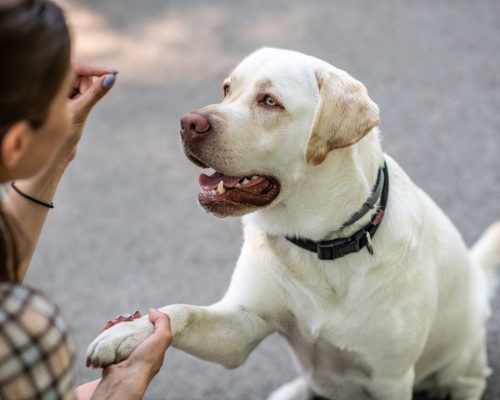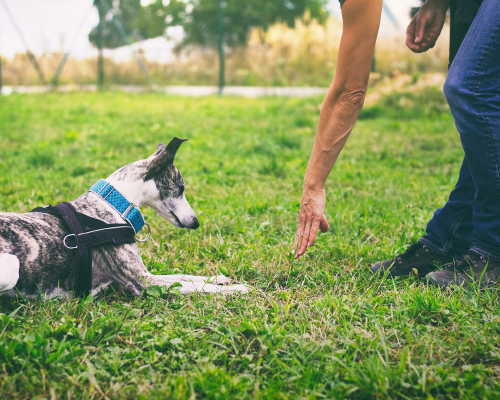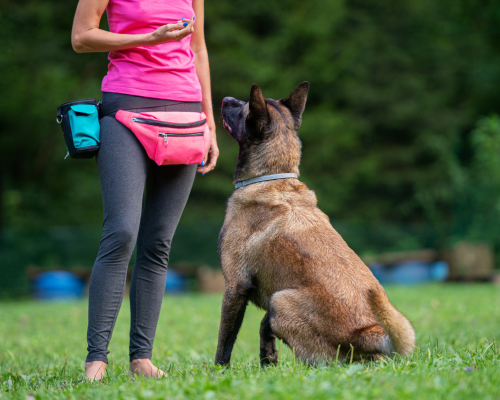5 Steps To Teaching a Dog Commands in Sign Language
5 Steps To Teaching a Dog Commands in Sign Language

Vet Reviewed

By: Sarah Hodgson
December 22, 2023
- Posted in Dogs
Table of Contents
Teaching a dog commands can be rewarding since they start to listen better and have the ability to communicate with you. While dogs are known for their ability to understand verbal commands, you can incorporate sign language into their training.
In this article, we will explore the advantages of teaching dog commands in sign language and provide a step-by-step guide on how to teach a dog commands in sign language.
So let's dive in!
The Benefits of Teaching Dog Commands In Sign Language
Before we dive into the 5 steps are there benefits to teaching your dog commands in sign language? Yes, there are!
Firstly, sign language can bridge the communication gap between humans and dogs, especially for dogs that may have hearing impairments. By using visual cues, you can effectively convey your commands to your dog and ensure they understand what is expected of them.
Secondly, Sign language also offers a universal language that can be understood by dogs regardless of their breed or background. This can be particularly helpful when working with rescue dogs or dogs with diverse backgrounds, as they may not be familiar with verbal commands in a specific language.
Thirdly, using sign language for training can enhance your dog's focus and concentration. Dogs are highly observant animals and are adept at picking up visual cues. By incorporating sign language into their training, you engage their attention and encourage them to stay focused on your instructions.

5 Steps To Teaching a Dog Commands in Sign Language
Step 1. Choose Clear and Distinct Signs
When teaching your dog commands in sign language, it is crucial to select signs that are clear and distinct. The key is to choose signs that can be easily distinguished from one another, ensuring that your dog can differentiate between commands.
To achieve this, use simple and natural hand movements that can be executed consistently. Avoid complex or confusing signs that may lead to misunderstandings. Remember, the goal is to establish a clear line of communication with your dog, so simplicity is key.
For example, when teaching the "sit" command, you can use a downward hand motion with your palm facing the ground. This gesture is easily recognizable and can be consistently used to convey the command.
Step 2. Use Positive Reinforcement
Positive reinforcement is a fundamental aspect of dog training, regardless of the method used. When teaching your dog commands in sign language, it is crucial to reinforce their understanding and compliance with positive rewards.
Rewarding your dog with treats, praise, or playtime when they successfully execute a command encourages them to repeat the desired behavior. This positive association strengthens their understanding of the sign language command and motivates them to continue learning.
Consistency is key when using positive reinforcement. Ensure that you reward your dog immediately after they perform the command correctly. This reinforces the connection between the sign and the expected behavior, making the training process more effective.
Step 3. Start with Basic Commands
When embarking on teaching your dog commands in sign language, it is essential to start with basic commands. This allows your dog to grasp the concept and build a solid foundation before moving on to more complex commands.
Begin with commands such as "sit," "stay," and "come." These commands are fundamental and provide a solid starting point for your dog's sign language training. As your dog becomes proficient in these basic commands, you can gradually introduce more advanced commands.
Consistency is crucial during this stage. Use the same signs consistently for each command, ensuring that you pair them with verbal cues if desired. This helps your dog understand the correlation between the sign and the associated behavior.

Step 4. Practice Regularly
Regular practice is essential for effective dog training. Dedicate regular sessions to practice the sign language commands with your dog. Short, frequent training sessions are often more effective than long, sporadic ones.
During these practice sessions, focus on reinforcing previously learned commands and introducing new ones. Remember to be patient and understanding. Dogs learn at different paces, so it is essential to tailor your training to your dog's individual needs and abilities.
Consistency is key when practicing sign language commands. Use the same signs and cues consistently to reinforce your dog's understanding. Practice in different environments to ensure that your dog can generalize their understanding of the commands.
Step 5. Gradually Introduce New Commands
Once your dog has mastered the basic commands, you can gradually introduce new commands to expand their sign language vocabulary. This step requires patience and a gradual progression to prevent overwhelming your dog.
Introduce one new command at a time and ensure that your dog has a solid understanding of it before moving on to the next. Building upon their existing knowledge helps reinforce their understanding and prevents confusion.
Remember to continue using positive reinforcement throughout this process. Reward your dog when they successfully execute the new command, and gradually reduce the frequency of rewards as they become more proficient.
Some Challenges You Will Face
Teaching your dog commands in sign language comes with its challenges. It isn't an easy task by any means.
Some dogs may initially struggle to understand the visual cues and require additional time and patience. It is essential to adapt the training method to suit your dog's individual needs and abilities.
Note
It is important to be consistent in your training approach. Inconsistency can confuse your dog and slow down their progress. You should make sure that all family members or people involved in the training use the same signs and cues to prevent any confusion.
The Bottom Line
So there you have it, teaching your dog commands in sign language can be rewarding but difficult, to say the least. By choosing clear signs, using positive reinforcement, starting with basic commands, practicing regularly, and gradually introducing new commands, you can successfully train your dog in sign language.
Remember to be patient, consistent, and understanding throughout the training process. With time and dedication, you can create a strong bond and start communicating visually through sign language.
Frequently Asked Questions
Why should I start with basic commands when teaching a dog sign language?
Starting with basic commands like "sit," "stay," or "come" is important because these commands lay the foundation for more advanced sign language training. Basic commands are easier for your dog to grasp initially, helping them understand the fundamental concept of associating a specific sign with a particular behavior. Once your dog has mastered these basics, you can progressively introduce more complex commands.
Why is it important to gradually introduce new commands when teaching a dog sign language?
Gradually introducing new commands is essential to prevent overwhelming your dog. Breaking down complex commands into smaller, manageable steps allows your dog to build on their existing knowledge.
Can sign language commands be effective for all dog breeds?
Yes! Sign language commands can be effective for all dog breeds, but the training approach may vary based on individual breed characteristics. While some breeds may excel in visual learning, others may rely more on scent or sound cues.

Subscribe to Petfluence!
Get updates on the latest posts and more from Petfluence straight to your inbox.